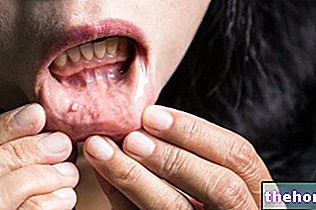So is gangrene
We speak of gangrene to indicate the death of a tissue or the decomposition of a part of the body following a blockage / lack of blood flow. The causes of gangrene are many and must be sought mainly in ischemia (due to embolisms or thrombi), bacterial infections, freezing or structural modifications of veins and arteries induced by diseases such as diabetes or atherosclerosis.

- Dry gangrene, typical complication of diabetes and atherosclerosis in which there is a progressive shrinking (mummification) of the affected limb / tissue; the cause is mainly of ischemic type without bacterial proliferation
- Moist (wet) gangrene, caused by a "bacterial infection that spreads inside the body from an open and inadequately treated wound; the cause is mainly of ischemic type resulting from bacterial proliferation
- Gaseous gangrene, induced by the proliferation of toxins produced by bacteria that live in the intestine and in the soil and which can infect tissues damaged by a wound
Signs and Symptoms
How to notice gangrene? First of all, it should be noted that the symptoms depend both on the type of gangrene (dry, wet, gaseous) and on the tissue / organ involved.
When the skin or a limb is involved (e.g. diabetic foot), gangrene manifests itself with symptoms such as:
- Skin discolouration: the skin takes on a bright red, brown, greenish or black tint
- The tissue is swollen, soft and rotten (typical clinical picture of wet gangrene)
- The limb is dry, black and withered, almost mummified (characteristic condition of dry gangrene)
- Fetid and foul-smelling odor coming from the involved tissue (wet gangrene)
- Loss of sensation in the area affected by gangrene: this event generally occurs following severe trauma or pain in the affected area
- Infected, purulent and / or bleeding wound
When the infection is internal to the body (gas gangrene), the symptoms are instead different:
- Confusion and general malaise
- Persistent generalized pain
- Fever
- Hypotension
- Presence of gas in the subcutaneous tissues
- Rapid breathing
- Septicemia (spread of infection in the blood)
- Tachycardia
Diagnosis
The diagnosis of gangrene is based primarily on anamnesis (clinical history reported by the patient) and on direct medical observation of the tissue presumably affected by necrosis. The physical examination is generally supported by a series of assessment tests, such as: blood tests (which, in the presence of gangrene, show an increase in white blood cells), radiographs and imaging studies (CT and / or MRI, to determine the extent of the damage suffered).
In patients with dry gangrene, an arteriogram is usually performed, which is essential to identify with certainty the blocked artery responsible for the symptoms.
A biopsy of infected tissue or purulent fluid emitted from the wound may be needed to identify the bacteria involved in the infection.
Care and intervention
Patients with gangrene require urgent medical evaluation and adequate and timely treatment to avoid complications, such as the generalized spread of the infection (in the presence of wet and gaseous gangrene).
Hospitalization of the patient is always essential in the event of ascertained gangrene.
The treatments of choice to cure gangrene and save the victim from bad luck are essentially surgery (removal of necrotic tissue or amputation of the limb involved) and aggressive antibiotic therapy.
DRY GANGRENA requires the restoration of the blood supply in the gangrenous area: the intervention of a vascular surgeon is therefore the only solution that can save the limb and the life of the patient when the gangrene has not yet spread. more serious, ie when the gangrene has progressed to the point that the blood supply cannot be restored, the only life-saving solution is the amputation of the diseased limb.
The patient suffering from WET CANCER must be treated with the administration of analgesics, essential to mask the excruciating pain caused by the infection. In addition to this therapy, wet gangrene requires the administration of broad spectrum antibiotics intravenously. The drugs most used for this purpose are penicillin, metronidazole and aminoglycosides. To support antibiotic treatment, the patient generally undergoes surgical removal of the gangrenous tissue (surgical debridement).
Again, amputation may be a viable option when gangrene cannot be controlled either by surgery or by antibiotics.
Constituting a real threat to the life of the patient, GANGRENA GASSOSA must be treated aggressively with surgical removal of the infected tissue supported by an intravenous antibiotic treatment, essential to prevent septicemia.
When gangrene is diagnosed at an advanced stage, the patient (when he survives) can undergo alternative and supportive therapy:
- To accelerate the healing of gangrene induced by infected wounds, the patient is sometimes treated with the administration of growth factors, hormones and skin grafts.
- Some patients with gas gangrene are treated with hyperbaric oxygen therapy, a particular medical practice capable of providing oxygen levels higher than the norm: in so doing, the growth of anaerobic bacteria is inhibited and wound healing is encouraged.
- An alternative and bizarre treatment is the Maggot therapy, which consists in the introduction of live worms or fly larvae into the open and necrotic wound, in order to clean the same from the bacteria involved in the infection.
Prevention in the diabetic patient
Patients most at risk of dry gangrene, that is, those suffering from diabetes, must pay extreme attention to the care and observation of their body. Diabetics in particular should be educated on the behavior to follow to prevent infections in general, trauma to feet and dry gangrene.
The feet of diabetics should always be adequately checked by a second person - be this a family member or a doctor - who ascertains the absence of skin lesions. We remember, in fact, that in the presence of diabetes, healing is much slower and patients they struggle to realize the trauma due to the progressive loss of sensation in the feet. Consequently, the failure to recognize a lesion (even as small as a small callus) could degenerate into bleeding ulcers, up to provoking - in extreme cases - gangrene.




























